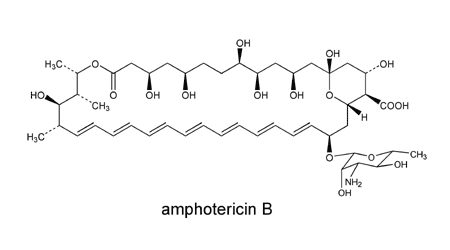Oral amphotericin B
Trade & Generic Names & General Features
Oral capsule and suspension forms of amphotericin B can be compounded or are available commercially. These formulations are poorly absorbed.

Mechanism(s) of Action
The antifungal activity of oral amphotericin B is via the mechanism noted for other amphotericin B formulations. It binds to sterols, preferentially to the primary fungal cell membrane sterol, ergosterol. This binding disrupts osmotic integrity of the fungal membrane, resulting in leakage of intracellular potassium, magnesium, sugars, and metabolites and then cellular death [2232].
Usual Doses
There is yet no validated standard dose of oral amphotericin B. It has so far been administered as 500 mg capsules four times a day [990] or in suspension form as 500 mg every six hours [1517]. A solution of 100 mg/ml has been made available commercially, and is dosed at 1 to 5 ml four times daily, taken as “swish and swallow.”
Side-Effects
Perhaps surprisingly, oral amphotericin B does not have an unpleasant taste. As it is poorly absorbed, the frequency of systemic should be (and has been) low [2160, 2161].
Routes
Oral amphotericin B is applicable in capsule and suspension forms [990, 1057].
Current Status
The primary early use of oral amphotericin formulations was as prophylaxis for fungal infections in high risk patients. While some reports suggested a possible role (perhaps via decreasing fungal burden in the GI tract) [34, 699, 1517], systemic therapies are now preferred. For example, oral itraconazole solution was proven to be superior to oral amphotericin B capsules in preventing superficial and systemic infections in neutropenic patients [990]. Perhaps more directly useful clues have been the clinical success achieved with oral amphotericin B in a number of patients with resistant oropharyngeal candidiasis [1057], including some cases infected with azole-resistant Candida glabrata [584].
Please also see our discussion on cost analysis and pharmacoeconomic analysis of antifungal therapy.
